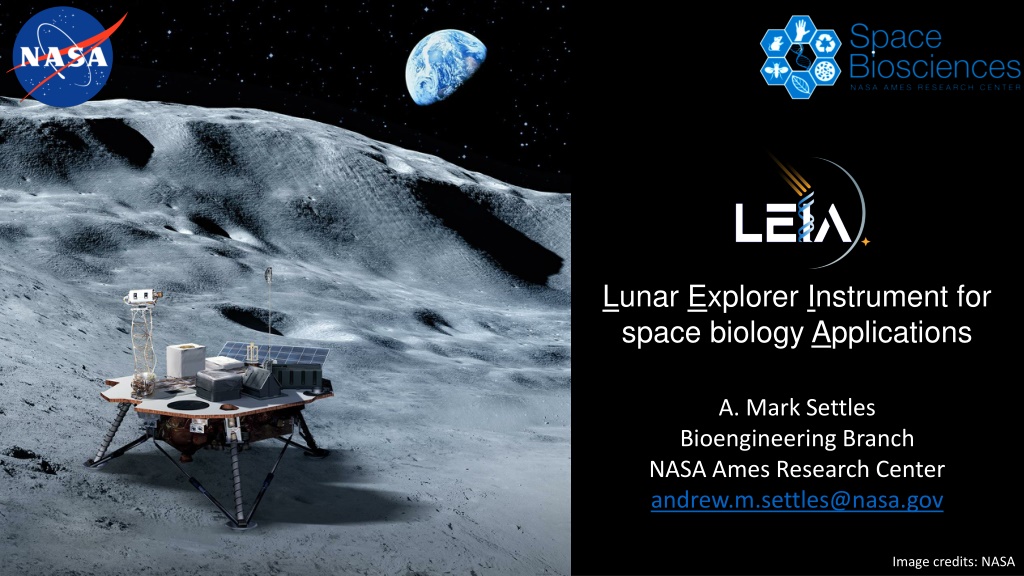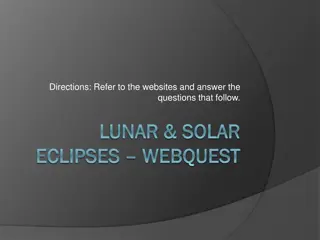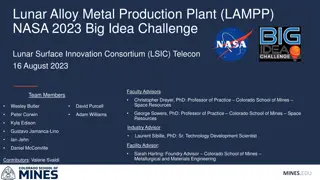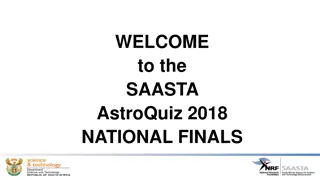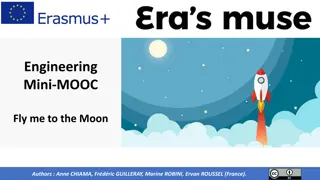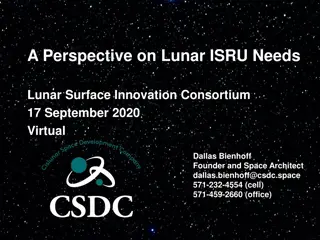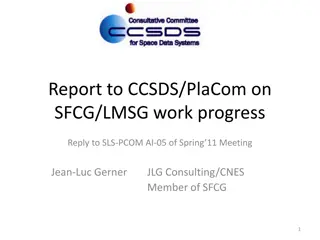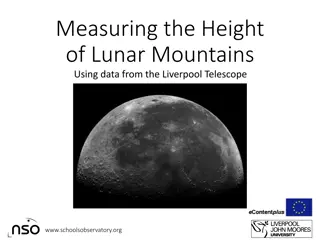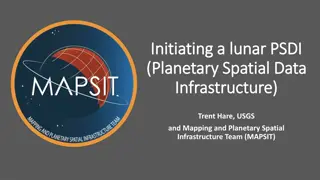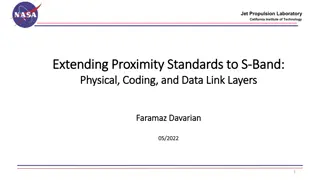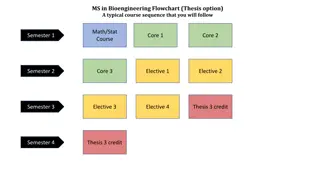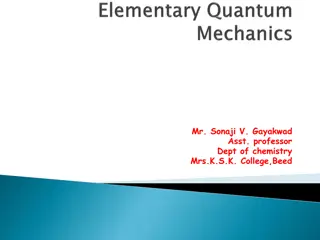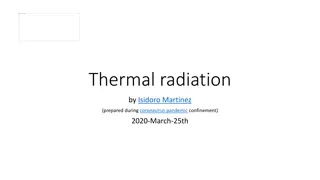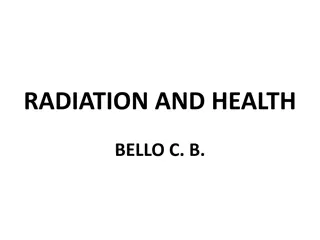Exploring Lunar Surface Radiation Risks and Mitigations Using Bioengineering
Lunar Explorer Instrument for space biology applications, LEIA Mission, addresses radiation health risks for crewed lunar exploration. The project aims to engineer yeast strains to study radiation sensitivity and identify genetic factors affecting cellular response. The instrument suite includes BioSensor for monitoring cell growth and ARES Timepix3 spectrometer for measuring charged particle radiation. Lunar surface radiation poses distinct challenges from deep space radiation, with fast neutrons causing direct cellular damage. Mitigations using in-space biomanufacturing are being explored beyond low Earth orbit for crew health.
Download Presentation

Please find below an Image/Link to download the presentation.
The content on the website is provided AS IS for your information and personal use only. It may not be sold, licensed, or shared on other websites without obtaining consent from the author. Download presentation by click this link. If you encounter any issues during the download, it is possible that the publisher has removed the file from their server.
E N D
Presentation Transcript
Lunar Explorer Instrument for space biology Applications A. Mark Settles Bioengineering Branch NASA Ames Research Center andrew.m.settles@nasa.gov Image credits: NASA
LEIA Mission Overview Motivation. What are the radiation health risks for crewed exploration of the lunar surface? Will proposed mitigations for crew health using in-space biomanufacturing be effective beyond low Earth orbit? Approach. Engineer yeast strains to test growth and metabolism for sensitivity to radiation. Measure biologically relevant radiation in transit and on the lunar surface. Central goal. Identify genetic factors impacting cellular response to lunar surface radiation and gravity. Artemis III candidate landing regions at the south pole Team: Dr. A. Mark Settles (PI), Dr. Sergio Santa Maria (Deputy PI), Dr. Donald M. Hassler (Co-I, SwRI), David Pletcher (PM), Leandro James (SE) For more information: https://www.nasa.gov/ames/leia Image credits: NASA
Radiation is a significant risk for organisms in deep space SB2022 ( -carotene) X-ray Protein & Ion Leaks Cellular Effects of ROS Damage Cell cycle arrest 23 C Peroxidation of lipids Heavy ion 25 C Low ATP 30 C Repressed translation DNA Damage 35 C Radiation causes cellular stress through DNA damage and Reactive Oxygen Species (ROS). Environmental stress ells shift energy from growth and production to repairing damage. Yeast is a good model to assess cellular effects of space radiation.
Lunar surface radiation is a distinct environment from deep space GCR Estimates of fast neutrons in lunar surface radiation % Fast Neutron Mission Project Dose Type Lunar Prospector LP Effective 16-18% LRO CRaTER Absorbed 0.7% Chang E 4 LND Absorbed 23% Lunar regolith absorbs galactic cosmic radiation (GCR) to produce secondary albedo neutrons High-energy, fast neutrons cause direct cellular damage Fast neutrons also produce ionizing radiation Estimates of surface neutron doses vary widely Image credits: NASA
LEIA Instrument suite BioSensor ARES LET Spectrometer BioSensor is a microfluidic culturing system to measure yeast growth and metabolism. ARES Timepix3 spectrometer measures charged particle radiation. Mini-FND is a fast neutron detector.
BioSensor monitors cell growth in microfluidic culture wells BioSensor Prototype Microfluidic Card Individual Cell Culture Well 4 cm ~5 cm For LEIA: BioSensor contains 16 microfluidic cards Pumps and valves control medium addition through 2 separate manifolds Each card has 16 culture wells (256 wells total) Each well can record light absorbance data at 3 LED wavelengths
LEIA benefits from lessons learned in BioSentinel missions Key mission accomplishments: Measured LEO radiation with Timepix. Demonstrated microfluidics and optics systems. Demonstrated yeast storage and growth. Mission Duration: 6 months 9 timepoints BioSentinel 2 strains -ISS Stress response Crewed LEO flight Key mission accomplishments: Measured deep space radiation with Timepix. Demonstrated microfluidics and optics systems. Demonstrated CubeSat avionics, COTS electronics, solar power system, and DSN comms. -Deep Space Mission Duration: 24 months 9 timepoints 2 strains Stress response Artemis I free-flyer Lessons Learned & Mission-specific changes: Late load capability to reduce yeast storage period. Improved ECLSS for the yeast storage period. Detect carotenoid production Add Mini-FND neutron detector. Surface Ops: 7-10 days 2 timepoints 16 strains Stress response Bioproduction Genetic countermeasures CLPS Lander Dec 2021Nov 2022 Nov 2024 late 2026 2013 BioSentinel ISS Deep Space LEIA CP-22
Project Team A. Mark Settles (Principal Investigator) Sergio Santa Maria (Deputy PI) Donald M. Hassler (Co-I, SwRI) David Pletcher (PM) Linda Timucin (Deputy PM) Engineering Team Leandro James (Lead SE) Earl Daley (Mechanical) Matt McKay Mike Padgen (Fluidics) Victor Yeh Brandon Schmitt (Software) Bryan Kirsch Mareyna Karlin Nicholas Stoffle (ARES) Brett Stroozas (OPS Lead) Steven Ormsby Alex Szerszen (Thermal) H. K. Vogelsong (I&T Lead) Shang Wu (Electrical) Nghia Mai Neil Davies Aidan Remy Mini-FND (SwRI) Michael Vincent (PM) Yvette D. Tyler (SE) Jianxin Chen Bent Ehresmann Bryan Pike Travis Smith Eddie Weigle Cary Zeitlin (JSC) Lu Zheng Science Team Natalie Ball Jared Broddrick Jessica Chau Natalya Dvorochkin Jennifer Gil Acevedo Diana Gentry Chinmayee Govinda Raj Aditya Hindupur Jessica Lee Lauren Liddell Jack Miller Sandra Vu SMA Mariano Perez (CSO) Ted Drude (SQA) NASA Interns Kylie Akiyama Jennifer Gil Acevedo Stephen Lantin Dylan F. Walsh Dunya Shuman Payne E. Turney Funding NASA PMPO - PRISM NASA BPS - Space Biology Image credits: NASA
